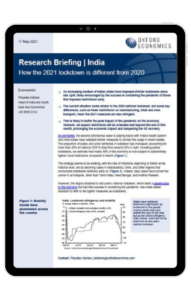India | How the 2021 lockdown is different from 2020

As we feared, the second coronavirus wave is playing havoc with India’s health system and more states have adopted stricter measures to contain the surge in recent weeks. The proportion of states and union territories in lockdown has increased, accounting for more than 65% of national GDP in May from around 22% in April. Including partial lockdowns, we estimate that nearly 80% of the economy is now subject to substantially tighter Covid restrictions compared to March.
What you will learn from this report:
- An increasing number of Indian states have imposed stricter lockdowns since late April, likely encouraged by the success in containing the pandemic of those that imposed restrictions early.
- The current situation looks similar to the 2020 national lockdown, but some key differences, such as fewer restrictions on manufacturing, retail and even transport, mean the 2021 measures are less stringent.
- This is likely to buffer the peak impact of the pandemic on the economy. However, we expect restrictions will be extended well beyond the end of this month, prolonging the economic impact and hampering the H2 recovery.
Tags:
Related Services

Post
UK: Supply constraints are probably less prominent in the south
The extent to which UK employers can respond to likely 2024 interest rate cuts with increased output, rather than rises in prices and wages, will partly reflect the extent of spare capacity. This will inevitably vary by region. Evidence on this is imperfect, but in terms of capital assets (including intangibles) and labour availability, southern regions appear to be in a stronger position than those in the UK's traditional industrial heartland.
Find Out More
Post
Global Private equity real estate fund maturities spur asset sales
We expect the significant increases in fund maturities, spurred by capital raised over the past decade, to exert upward pressure on the rate of asset disposals as the funds approach the end of their lifecycles.
Find Out More